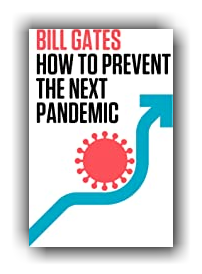|
|
|
|
|
Book Review – Context is Crucial |
|
In How to Prevent the Next Pandemic, Bill Gates presents a cogent, scientific approach to pandemic prevention rooted in lessons learned from COVID-19, without satisfactorily addressing matters of government and science skepticism as well as mis/disinformation. This book offers a robust overview of what worked in COVID-19 by culling observations from across the globe on strengths and weaknesses in public health systems, governments, and technological applications. Gates outlines how we can learn from the COVID-19 experience and better prepare for the future, but stops short of contending with the current societal context. |
|
|
|
A third of the chapter titles contain an expression of timeliness or rapidity: “Get better at detecting outbreaks early”, “Help people protect themselves right away”, “Find new treatments fast,” and this is how a sizable portion of the book struck me—continuing research and streamlining processes to do what we are already doing faster and better. There were some exceptions. Gates suggests the creation of a global team whose aim is to detect and prevent outbreaks from developing into pandemics. He approximates this aim could be achieved with a decentralized, cross-disciplinary team of 3,000 individuals (epidemiologists, bioinformaticians, logistics planners, etc.) He presents a comprehensive overview of this global task force dedicated to disease surveillance and response, which he names the GERM (Global Epidemic Response and Mobilization) team. This seems like a feasible, valuable addition to the global public health landscape inasmuch as it establishes a designated task force with communication lines across disciplines and across the globe. However, the book aims to prevent the next pandemic, and to do so, I think we must deal with our current context. Two of the most central issues which handicapped the United States’ response to the pandemic were lack of a coordinated, uniform response across the federal, state, and local levels, and mis/disinformation often stemming from a mistrust of government and science. Gates mentions these without offering a clear path forward. Several critical steps of pandemic response—doing the right things early, people electing to test themselves and report their results, people electing to vaccinate—are predicated upon a baseline level of trust in scientific research and/or government. Within the United States, COVID-19 revealed deep schisms in the nation, and that in some areas public trust in government and science is injured and eroded. To ignore this reality is to face the fallout unprepared. Addressing reservations, let alone outright opposition, is non-trivial. Research (here and here) on misinformation, conspiracy theories and those who subscribe to them indicates that worldview-threatening information can be presented in a manner that abates psychological resistance (the so-called “Backfire Effect”) when that information is coupled with self-affirmation. Research also demonstrates that presenting people who hold extreme beliefs with even more extreme arguments supporting their beliefs actually caused them to take a more moderate position compared to conventional persuasive approaches. Gates aptly states that “good science is messy, uncertain, and prone to change.” In addition to vigilance against mis/disinformation, public health needs a scientific diplomacy team to build bridges and inroads for public trust in science while acknowledging its limitations. If you’re an epidemiologist or work in public health, much of the book will not be novel to you. This book is suited for those interested in a comprehensive overview of what worked well in the fight against COVID-19 and how it can be built upon for future outbreaks. Mr. Gates is a believer—in innovation and technology. Here, he nicely compiles the science of pandemics and discusses the next iteration of innovation. I share his enthusiasm and applaud his optimism in a time when both are in short supply, but innovation, technology, and science will only take us so far as public confidence therein is not eroded. ■ |
|
|

